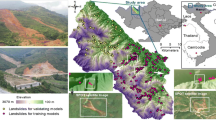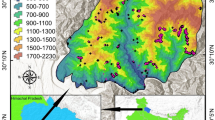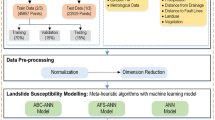Abstract
In this paper, the artificial bee colony (ABC) algorithm is used to generate landslide susceptibility maps. To the best of our knowledge, it is the first time the ABC algorithm is applied as a classifier on landslide susceptibility mapping. Twelve features are considered as inputs for the ABC model in this research work. These features contain redundant and correlated information. Therefore, normalization and dimension reduction are applied in the pre-processing stage. Three different normalization methods are investigated, i.e. minimum and maximum (Min-Max), mean standard deviation (Mean-SD), and median and interquartile range (Med-IQR). Two dimensionality reduction techniques, i.e., principal component analysis (PCA) and canonical variate analysis (CVA), are utilized to deal with high-dimensional information and eliminate correlated information in the data. In total, six different schemes of input data based on the three normalization methods and two techniques of dimension reduction are applied to train the ABC model. There are a total of 382 landslide incidents occurred at various locations on Penang Island, out of which 255 are selected for training and remaining 127 are used for the validation purpose of the model. The model classification accuracies and receiver of characteristics (ROC) curve are applied to evaluate the model’s performance. The results show that the ABC model trained using Min-Max normalization and CVA scheme generates the best results among these six schemes. The landslide susceptibility maps generated in this research offer significant information for landslide risk management.








Similar content being viewed by others
References
Cruden, D.M.: A simple definition of a landslide. Bullet. Int. Assoc. Eng. Geol. 43(1), 27–29 (1991). https://doi.org/10.1007/BF02590167
Varnes, DJ.: Landslide hazard zonation : A review of principles and practice. Natural Hazards, \(3^{rd}\) edition, UNESCO Press, Paris, 64 pp. https://trid.trb.org/view/281932 (1984)
Chen, W.; Xie, X.; Wang, J.; Pradhan, B.; Hong, H.; Bui, D.T.; Duan, Z.; Ma, J.: A comparative study of logistic model tree, random forest, and classification and regression tree models for spatial prediction of landslide susceptibility. Catena 151, 147–160 (2017). https://doi.org/10.1016/j.catena.2016.11.032
Kim Huat, B.; Ali, F.; Baker, DH.; Singh, H.; Omar, H.: Landslides in Malaysia : occurrences, assessment, analyses and remediation. Penerbitan Universiti Putra Malaysia, Serdang, Selangor. http://psasir.upm.edu.my/id/eprint/32542 (2008)
Saro, L.; Woo, J.S.; Kwan-Young, O.; Moung-Jin, L.: The spatial prediction of landslide susceptibility applying artificial neural network and logistic regression models: A case study of Inje. Korea. Open Geosci. 8(1), 117–132 (2016). https://doi.org/10.1515/geo-2016-0010
Tsangaratos, P.; Benardos, A.: Estimating landslide susceptibility through a artificial neural network classifier. Natural Hazards 74(3), 1489–1516 (2014). https://doi.org/10.1007/s11069-014-1245-x
Sassa, K.: 2006 Tokyo Action Plan–strengthening research and learning on landslides and related earth system disasters for global risk preparedness. Landslides 3, 361–369 (2006). https://doi.org/10.1007/s10346-006-0065-9
Qasim, S.; Harahap, I.S.H.; Osman, S.B.S.: Causal factors of Malaysian landslides: a narrative study. Res. J. Appl. Sci., Eng. Technol. 5(7), 2303–2308 (2013). https://doi.org/10.19026/rjaset.5.4656
Cheng, T.A.; Lateh, H.; Peng, KS.: Intelligence explanation system on landslide dissemination: a case study in Malaysia. In Proceedings of the first world landslide forum report: Implementing the 2006 Tokyo action plan on the international program on landslides (IPL), pp 581–584. http://www.iclhq.org/WLFweb/parallel_sessions.pdf (2006)
Ting, W.H.: Stability of slopes in Malaysia. In Proceedings Symposium on Geotechnical Aspects of Mass and Material Transportation, Bangkok, pp 119–128. (1984)
Gian Quoc, A.; Duc-Tan, T.; Nguyen Dinh, C.; Tien Bui, D.: Flexible configuration of wireless sensor network for monitoring of rainfall-induced landslide. Indones. J. Electr. Eng. Comput. Sci. 12(3), 1030–1036 (2018). https://doi.org/10.11591/ijeecs.v12.i3.pp1030-1036
Yaácob, N.; Tajudin, N.; Azize, A.M.: Rainfall-landslide early warning system (RLEWS) using TRMM precipitation estimates. Indones. J. Electr. Eng. Comput. Sci. 13(3), 1259–1266 (2019). https://doi.org/10.11591/ijeecs.v13.i3.pp1259-1266
Lee, S.; Talib, J.A.: Probabilistic landslide susceptibility and factor effect analysis. Environ. Geol. 47(7), 982–990 (2005). https://doi.org/10.1007/s00254-005-1228-z
Tay, L.T.; Alkhasawneh, M.S.; Lateh, H.; Hossain, K.; Kamil, A.A.: Landslide hazard mapping of Penang Island using poisson distribution with dominant factors. J. Civil Eng. Res. 4(3A), 72–77 (2014)
Fell, R.; Corominas, J.; Bonnard, C.; Cascini, L.; Leroi, E.; Savage, W.Z.: Guidelines for landslide susceptibility, hazard and risk zoning for land use planning. Eng. Geol. 102(3–4), 85–98 (2008). https://doi.org/10.1016/j.enggeo.2008.03.022
Akgun, A.; Dag, S.; Bulut, F.: Landslide susceptibility mapping for a landslide-prone area (Findikli, NE of Turkey) by likelihood-frequency ratio and weighted linear combination models. Environ. Geol. 54(6), 1127–1143 (2008). https://doi.org/10.1007/s00254-007-0882-8
Dahal, R.K.; Hasegawa, S.; Nonomura, A.; Yamanaka, M.; Masuda, T.; Nishino, K.: GIS-based weights-of-evidence modelling of rainfall-induced landslides in small catchments for landslide susceptibility mapping. Environ. Geol. 54(2), 311–324 (2008). https://doi.org/10.1007/s00254-007-0818-3
Girma, F.; Raghuvanshi, T.K.; Ayenew, T.; Hailemariam, T.: Landslide hazard zonation in Ada Berga district, Central Ethiopia - a GIS based statistical approach. J. Geom. 9(1), 25–38 (2015)
Lee, S.; Pradhan, B.: Probabilistic landslide hazards and risk mapping on Penang Island. Malaysia. J. Earth Syst. Sci. 115(6), 661–672 (2006). https://doi.org/10.1007/s12040-006-0004-0
Hamza, T.; Raghuvanshi, T.K.: GIS based landslide hazard evaluation and zonation - A case from Jeldu District, Central Ethiopia. J. King Saud Univ. - Sci. 29(2), 151–65 (2017). https://doi.org/10.1016/j.jksus.2016.05.002
Lamelas, M.T.; Marinoni, O.; Hoppe, A.; De La Riva, J.: Doline probability map using logistic regression and GIS technology in the central Ebro Basin (Spain). Environ. Geol. 54(5), 963–977 (2008). https://doi.org/10.1007/s00254-007-0895-3
Lee, S.: Application of logistic regression model and its validation for landslide susceptibility mapping using GIS and remote sensing data. Int. J. Remote Sens. 26(7), 1477–1491 (2005). https://doi.org/10.1080/01431160412331331012
Luigi, L.; Martin, P.: Presenting logistic regression-based landslide susceptibility results. Eng. Geol. 244, 14–24 (2018). https://doi.org/10.1016/j.enggeo.2018.07.019
Sun, X.; Chen, J.; Bao, Y.; Han, X.; Zhan, J.; Peng, W.: Landslide susceptibility mapping using logistic regression analysis along the Jinsha River and its tributaries close to Derong and Deqin County Southwestern China. ISPRS Int. J. Geo-Inform. (2018). https://doi.org/10.3390/ijgi7110438
Chen, W.; Fan, L.; Li, C.; Pham, B.T.: Spatial Prediction of Landslides Using Hybrid Integration of Artificial Intelligence Algorithms with Frequency ratio and index of entropy in Nanzheng County. China. Appl. Sci. 10(1), 29 (2020). https://doi.org/10.3390/app10010029
Regmi, A.D.; Devkota, K.C.; Yoshida, K.; Pradhan, B.; Hamid Reza, P.; Takashi, K.; Akgun, A.: Application of frequency ratio, statistical index, and weights-of-evidence models and their comparison in landslide susceptibility mapping in Central Nepal Himalaya. Arab. J. Geosci. 7, 725–742 (2014). https://doi.org/10.1007/s12517-012-0807-z
Yx, Zhang; Hx, Lan; Lp, Li; Yu-ming, W.; Jun-hui, C.; Nai-man, T.: Optimizing the frequency ratio method for landslide susceptibility assessment: a case study of the Caiyuan Basin in the southeast mountainous area of China. J. Mount. Sci. 17, 340–357 (2020). https://doi.org/10.1007/s11629-019-5702-6
Alkhasawneh, M.S.; Ngah, U.K.; Tay, L.T.; Mat Isa, N.A.: Determination of importance for comprehensive topographic factors on landslide hazard mapping using artificial neural network. Environ. Earth Sci. 72(3), 787–799 (2014a). https://doi.org/10.1007/s12665-013-3003-x
Alkhasawneh, M.S.; Ngah, U.K.; Tay, L.T.; Mat Isa, N.A.; Al-Batah, M.S.: Modeling and testing landslide hazard using decision tree. J. Appl. Math. (2014b). https://doi.org/10.1155/2014/929768
Chen, W.; Pourghasemi, H.R.; Naghibi, S.A.: Prioritization of landslide conditioning factors and its spatial modeling in shangnan county, china using gis-based data mining algorithms. Bullet. Eng. Geol. Environ. 77, 611–629 (2018). https://doi.org/10.1007/s10064-017-1004-9
Wang, L.J.; Guo, M.; Sawada, K.; Lin, J.; Zhang, J.: A comparative study of landslide susceptibility maps using logistic regression, frequency ratio, decision tree, weights of evidence and artificial neural network. Geosci. J. 20, 117–136 (2016). https://doi.org/10.1007/s12303-015-0026-1
Chen, W.; Chen, X.; Peng, J.; Panahi, M.; Lee, S.: Landslide susceptibility modeling based on ANFIS with teaching-learning-based optimization and Satin bowerbird optimizer. Geosci. Front. 12(1), 93–107 (2021). https://doi.org/10.1016/j.gsf.2020.07.012
Xi, C.; Wei, C.: GIS-based landslide susceptibility assessment using optimized hybrid machine learning methods. CATENA 196, 104833 (2021). https://doi.org/10.1016/j.catena.2020.104833
Bakhtiyari, K.; Husain, H.: Fuzzy model of dominance emotions in affective computing. Neural Comput. Appl. 25(6), 1467–1477 (2014). https://doi.org/10.1007/s00521-014-1637-6
Rezaee Jordehi, A.; Jasni, J.: Heuristic methods for solution of FACTS optimization problem in power systems. In Proceedings of IEEE Student Conference on Research and Development, Cyberjaya, pp 30–35. https://doi.org/10.1109/SCOReD.2011.6148703 (2011)
Taghavi, M.; Bakhtiyari, K.; Scavino, E.: Agent-Based Computational Investing Recommender System. In RecSys 2013 - Proceedings of the \(7^{th}\) ACM Conference on Recommender Systems, Hong Kong, pp 455–458. https://doi.org/10.1145/2507157.2508072 (2013)
Rezaee Jordehi, A.; Jasni, J.; Abdul Wahab, NI.; Abd Kadir, MZA.: Particle swarm optimisation applications in FACTS optimisation problem. In Proceedings of the IEEE \(7^{th}\) International Power Engineering and Optimization Conference (PEOCO), Langkawi, pp 193–198. https://doi.org/10.1109/PEOCO.2013.6564541 (2013)
Jordehi, A.R.: Enhanced leader PSO (ELPSO): a new PSO variant for solving global optimisation problems. Appl. Soft Comput. 26, 401–417 (2015b). https://doi.org/10.1016/j.asoc.2014.10.026
Rezaee Jordehi, A.: Particle swarm optimisation for dynamic optimisation problems: a review. Neural Comput. Appl. 25(7–8), 1507–1516 (2014). https://doi.org/10.1007/s00521-014-1661-6
Holland, JH.: Adaptation in natural and artificial systems: An introductory analysis with applications to biology, control, and artificial intelligence. MIT Press, USA. https://ieeexplore.ieee.org/servlet/opac?bknumber=6267401 (1992)
Karaboga, D.: An idea based on Honey Bee Swarm for Numerical Optimization. Technical report-TR06, Erciyes university, engineering faculty, computer engineering department, 200:1–10. https://abc.erciyes.edu.tr/pub/tr06_2005.pdf (2005)
Karaboga, D.; Akay, B.: A comparative study of Artificial Bee Colony algorithm. Appl. Math. Comput. 214(1), 108–132 (2009). https://doi.org/10.1016/j.amc.2009.03.090
Karaboga, D.; Gorkemli, B.: A quick artificial bee colony (qABC) algorithm and its performance on optimization problems. Appl. Soft Comput. 23, 227–238 (2014). https://doi.org/10.1016/j.asoc.2014.06.035
Karaboga, D.; Basturk, B.: A powerful and efficient algorithm for numerical function optimization: Artificial bee colony (ABC) algorithm. J. Global Optim. 39(3), 459–471 (2007). https://doi.org/10.1007/s10898-007-9149-x
Zhu, G.; Kwong, S.: Gbest-guided artificial bee colony algorithm for numerical function optimization. Appl. Math. Comput. 217(7), 3166–3173 (2010). https://doi.org/10.1016/j.amc.2010.08.049
Blum, C.: Ant colony optimization: introduction and recent trends. Phys. Life Rev. 2(4), 353–373 (2005). https://doi.org/10.1016/j.plrev.2005.10.001
Dorigo, M.; Maniezzo, V.; Colorni, A.: Ant system: optimization by a colony of cooperating agents. IEEE Trans. Syst., Man, Cybern., Part B (Cybern.), 26(1), 29–41 (1996). https://doi.org/10.1109/3477.484436
Jordehi, A.R.: Chaotic bat swarm optimisation (CBSO). Appl. Soft Comput. 26, 523–530 (2015a). https://doi.org/10.1016/j.asoc.2014.10.010
Yang, X.S.: A New Metaheuristic Bat-Inspired Algorithm. In: González, J.R., Pelta, D.A., Cruz, C., Terrazas, G., Krasnogor, N. (eds.) Nature Inspired Cooperative Strategies for Optimization (NICSO 2010). Studies in Computational Intelligence, Springer, Berlin (2010). https://doi.org/10.1007/978-3-642-12538-6_6
Huqqani, I.A.; Tay, L.T.; Mohamad-Saleh, J.: Analysis of landslide hazard mapping of penang island Malaysia using bivariate statistical methods. Indones. J. Electr. Eng. Comput. Sci. 16(2), 781–786 (2019). https://doi.org/10.11591/ijeecs.v16.i2.pp781-786
Huqqani, I.A.; Tay, L.T.; Mohamad-Saleh, J.: Landslide hazard analysis using a multilayered approach based on various input data configurations. Geosfera Indonesia 6(1), 20–39 (2021). https://doi.org/10.19184/geosi.v6i1.23347
Tay, L.T.; Alkhasawneh, M.S.; Ngah, U.K.; Lateh, H.: Landslide hazard mapping with new topographic factors: a study case of Penang Island, Malaysia. Aus. J. Basic Appl. Sci. 8(4), 387–392 (2014b)
Lim Khai - Wern, K.; Lea Tien, T.; Lateh, H.: Landslide Hazard Mapping of Penang Island Using Probabilistic Methods and Logistic Regression. In IEEE International Conference on Imaging Systems and Techniques,Penang, pp 273–278. https://doi.org/10.1109/IST.2011.5962174 (2011)
Pradhan, B.; Lee, S.: Delineation of landslide hazard areas on Penang Island, Malaysia, by using frequency ratio, logistic regression, and artificial neural network models. Environ. Earth Sci. 60(5), 1037–1054 (2010). https://doi.org/10.1007/s12665-009-0245-8
Murakami, S.; Tay, L.T.; Omar, R.; Nishigaya, T.; Aziza, N.; Roslan, R.; Baharuddin, I.; Lateh, H.; Sakai, N.: Landslides hazard map in Malay Peninsula by using historical landslide database and related information. J. Civil Eng. Res. 4(3A), 54–58 (2014). https://doi.org/10.5923/c.jce.201402.08
Varnes, D.J.: Slope Movement Types and Processes. In: Schuster, R.L., Krizek, R.J. (eds.) Landslides:analysis and control, special report 176, TRB. National research Council, Washington DC (1978)
Chen, Y.; Song, L.; Liu, Y.; Yang, L.; Li, D.: A review of the artificial neural network models for water quality prediction. Appl. Sci. 10(17), 5776 (2020). https://doi.org/10.3390/app10175776
Dobbin, K.K.; Simon, R.M.: Optimally splitting cases for training and testing high dimensional classifiers. BMC Med. Genom. 4, 31 (2011). https://doi.org/10.1186/1755-8794-4-31
Guzzetti, F.; Carrara, A.; Cardinali, M.; Reichenbach, P.: Landslide hazard evaluation: a review of current techniques and their application in a multi-scale study. Central Italy. Geomorphol. 31(1–4), 181–216 (1999). https://doi.org/10.1016/S0169-555X(99)00078-1
Van Westen, C.J.; Rengers, N.; Soeters, R.: Use of geomorphological information in indirect landslide susceptibility assessment. Natural Hazards 30(3), 399–419 (2003). https://doi.org/10.1023/B:NHAZ.0000007097.42735.9e
Westen, CJ.: Application of Geographic Information Systems to Landslide Hazard Zonation. http://www.itc.nl/library/Papers_1993/phd/vanwesten.pdf (1993)
Shalabi, L.; Zyad, S.; Al-Kasasbeh, B.: Data mining: a preprocessing engine. J. Comput. Sci. 2(9), 735–739 (2006). https://doi.org/10.3844/jcssp.2006.735.739
Patro, SG.; Sahoo, P.; Panda, I.; Sahu, KK.: Technical Analysis on Financial Forecasting. arXiv preprint. arXiv:1503.03011 (2015)
Vlachos, M.: Dimensionality Reduction. In: Sammut C, Webb GI (eds) Encyclopedia of Machine Learning. Springer, Boston, MA, pp 274–279. https://doi.org/10.1007/978-0-387-30164-8_216 (2011)
Riba Ruiz, J.; Canals, T.; Cantero Gomez, R.: Comparative study of multivariate methods to identify paper finishes using infrared spectroscopy. IEEE Trans. Instrum. Measurement 61(4), 1029–1036 (2012). https://doi.org/10.1109/TIM.2011.2173048
Jolliffe, I.T.; Cadima, J.: Principal component analysis: : a review and recent developments. Philos. Trans. Royal Soc. A 374, 20150202 (2016). https://doi.org/10.1098/rsta.2015.0202
Everitt, B.S.: Principles of multivariate analysis. J. Royal Stat. Soc.: Series A (Stat. Soc.) 152, 264–265 (1989). https://doi.org/10.2307/2982935
Nørgaard, L.; Bro, R.; Westad, F.; Engelsen, S.B.: A modification of canonical variates analysis to handle highly collinear multivariate data. J. Chemom. 20(8–10), 425–435 (2006). https://doi.org/10.1002/cem.1017
Gittins, R.: Canonical analysis : a review with applications in ecology. Biomathematics. Springer-Verlag, Berlin Heidelberg (1985). https://doi.org/10.1007/978-3-642-69878-1
Krzanowski, W.J.: Ranking principal components to reflect group structure. J. Chemom. 6(2), 97–102 (1992). https://doi.org/10.1002/cem.1180060207
Yendle, P.W.; MacFie, H.J.H.: Discriminant principal components analysis. J. Chemom. 3(4), 589–600 (1989). https://doi.org/10.1002/cem.1180030407
Hotelling, H.: The most predictable criterion. J. Edu. Psychol. 26(2), 139–142 (1935). https://doi.org/10.1037/h0058165
Bahamish, H.; Abdullah, R.; Abdul Salam, R.: Protein Tertiary Structure Prediction Using Artificial Bee Colony Algorithm. In: \(3^{rd}\) Asia International Conference on Modelling and Simulation, Bali, pp 258–263. https://doi.org/10.1109/AMS.2009.47 (2009)
Karaboga, N.: A new design method based on artificial bee colony algorithm for digital IIR filters. J. Frankl. Inst. 346(4), 328–348 (2009). https://doi.org/10.1016/j.jfranklin.2008.11.003
Karaboga, D.; Akay, B.; Ozturk, C.: Artificial Bee Colony (ABC) optimization algorithm for training feed-forward neural networks LNCS: modeling decisions for artificial intelligence, pp. 318–329. Springer, Berlin Heidelberg (2007). https://doi.org/10.1007/978-3-540-73729-2_30
Basturk, B.; Karaboga, D.: An artificial bee colony (ABC) algorithm for numeric function optimization. Proceedings of the IEEE swarm intelligence symposium, Indianapolis, IN, USA 2006, 12–14 (2006)
Javed, A.; Larijani, H.; Ahmadinia, A.; Emmanuel, R.: Random neural netwrok learning heuristics. Probab. Eng. Inform. Sci. 31(4), 436–456 (2017). https://doi.org/10.1017/S0269964817000201
Sarkar, M.; Yegnanarayana, B.; Khemani, D.: A clustering algorithm using an evolutionary programming-based approach. Pattern Recognit. Lett. 18(10), 975–986 (1997). https://doi.org/10.1016/S0167-8655(97)00122-0
Kumar, Y.; Sahoo, G.: A two-step artificial bee colony algorithm for clustering. Neural Comput. Appl. 28(3), 537–551 (2017). https://doi.org/10.1007/s00521-015-2095-5
Karaboga, D.; Ozturk, C.: A novel clustering approach: Artificial Bee Colony (ABC) algorithm. Appl. Soft Comput. 11(1), 652–657 (2011). https://doi.org/10.1016/j.asoc.2009.12.025
Pourtaghi, Z.S.; Pourghasemi, H.R.: GIS-based groundwater spring potential assessment and mapping in the Birjand Township, southern Khorasan Province. Iran. Hydrogeol. J. 22, 643–662 (2014). https://doi.org/10.1007/s10040-013-1089-6
Chen, W.; Pradhan, B.; Li, S.; Shahabi, H.; Rizeei, H.M.; Hou, E.; Wang, S.: Novel hybrid integration approach of bagging-based Fisher’s linear discriminant function for groundwater potential analysis. Natural Resour. Res. 28, 1239–1258 (2019). https://doi.org/10.1007/s11053-019-09465-w
Chen, W.; Shahabi, H.; Shirzadi, A.; Hong, H.; Akgun, A.; Tian, Y.; Liu, J.; Zhu, A.X.; Li, S.: Novel hybrid artificial intelligence approach of bivariate statistical-methods-based kernel logistic regression classifier for landslide susceptibility modeling. Bullet. Eng. Geol. Environ. 78(6), 4397–4419 (2019). https://doi.org/10.1007/s10064-018-1401-8
Chung, C.J.; Fabbri, A.: Probabilistic prediction models for landslide hazard mapping. Photogramm. Eng. Rem. Sens. 65(12), 1389–1399 (1999)
Acknowledgements
This research is funded by Kementerian Pendidikan Malaysia (KPM) for providing technical and financial support (FRGS – Geran Penyelidikan Fundamental FRGS/1/2018/TK04/USM/02/6).
Author information
Authors and Affiliations
Corresponding author
Rights and permissions
About this article
Cite this article
Huqqani, I.A., Tay, L.T. & Mohamad-Saleh, J. Assessment of Landslide Susceptibility Mapping Using Artificial Bee Colony Algorithm Based on Different Normalizations and Dimension Reduction Techniques. Arab J Sci Eng 47, 7243–7260 (2022). https://doi.org/10.1007/s13369-021-06013-8
Received:
Accepted:
Published:
Issue Date:
DOI: https://doi.org/10.1007/s13369-021-06013-8




